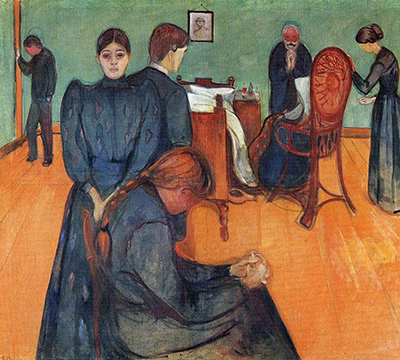In Death in the Sickroom, painted in 1895, Munch paints a scene from his own life, the death of his older sister Sophie.
She was only 15 when she died of tuberculosis, and Munch was a year younger; in this painting, though, he shows himself and the rest of the family as they were at the date of the painting,nearly twenty years later. Sophie is sitting in the high-backed chair by the bed, and is almost invisible. The rest of the family are shown scattered around the room; two sisters are in the foreground, with Edvard next to them, turning towards the bed, while Munch's father and aunt Karen (who brought up the family after the death of his mother) are by the bed. Meanwhile brother Andreas, on the left, seems to be trying to escape this claustrophobic room.
Each person is alone. None are looking at each other or engaging with each other; they are locked in their private worlds of grief. Younger sister Laura, in the foreground, sits in a dejected reflection of her older sister's pose, her head bowed; the white-bearded father stares straight ahead, his hands clasped in prayer; and another sister stares straight out of the picture, like many of Munch's figures creating a sort of icon of emotional turmoil.
The composition is simple and stark; there is a reddish-orange floor, and turquoise walls, dividing the picture horizontally, and figures in blue-grey clothes are strewn across this background, with a central focus on the group of two sisters in the foreground. The colour palette is extremely restricted, particularly compared to other paintings by Munch; that might reflect the closing-down of other emotions by grief, or simply the custom of wearing black clothes for mourning.
Death in the Sickroom is a painting about grief and loneliness. None of the family are able to ask other family members for comfort; they are all alone with their feelings, confronted with the presence of death. "We all die alone," Munch might be saying. Meanwhile Sophie, dying or perhaps already dead, has receded from the world of the painting; it's the survivors who have to deal with their feelings.




